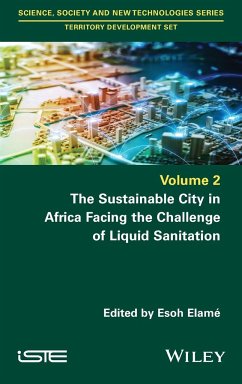The Sustainable City in Africa Facing the Challenge of Liquid Sanitation
Herausgeber: Elamé, Esoh
The Sustainable City in Africa Facing the Challenge of Liquid Sanitation
Herausgeber: Elamé, Esoh
- Gebundenes Buch
- Merkliste
- Auf die Merkliste
- Bewerten Bewerten
- Teilen
- Produkt teilen
- Produkterinnerung
- Produkterinnerung
This book questions the role of liquid sanitation in the development of cities in Africa. The absence of sewerage networks and treatment plants in African cities already submerged by rapid and anarchic urbanization is a major problem. To meet this challenge, it is urgent to rethink urban water governance and impose and enforce sustainable urban planning standards. In other words, sanitation issues must now be placed at the heart of urban planning.
Andere Kunden interessierten sich auch für
![Future Challenges in Evaluating and Managing Sustainable Development in the Built Environment Future Challenges in Evaluating and Managing Sustainable Development in the Built Environment]() Future Challenges in Evaluating and Managing Sustainable Development in the Built Environment153,99 €
Future Challenges in Evaluating and Managing Sustainable Development in the Built Environment153,99 €![The Water Sensitive City The Water Sensitive City]() Gary GrantThe Water Sensitive City83,99 €
Gary GrantThe Water Sensitive City83,99 €![Biosphere Reserves and Sustainable Development Goals 2 Biosphere Reserves and Sustainable Development Goals 2]() Biosphere Reserves and Sustainable Development Goals 2164,99 €
Biosphere Reserves and Sustainable Development Goals 2164,99 €![Biosphere Reserves and Sustainable Development Goals 1 Biosphere Reserves and Sustainable Development Goals 1]() Biosphere Reserves and Sustainable Development Goals 1164,99 €
Biosphere Reserves and Sustainable Development Goals 1164,99 €![Sustainable Development Sustainable Development]() Mark MawhinneySustainable Development118,99 €
Mark MawhinneySustainable Development118,99 €![Evaluating Sustainable Development in the Built Environment Evaluating Sustainable Development in the Built Environment]() Peter BrandonEvaluating Sustainable Development in the Built Environment97,99 €
Peter BrandonEvaluating Sustainable Development in the Built Environment97,99 €![Management of a sewage collective network in an urban area Management of a sewage collective network in an urban area]() Ewanoge MesumbeManagement of a sewage collective network in an urban area36,99 €
Ewanoge MesumbeManagement of a sewage collective network in an urban area36,99 €-
-
-
This book questions the role of liquid sanitation in the development of cities in Africa. The absence of sewerage networks and treatment plants in African cities already submerged by rapid and anarchic urbanization is a major problem. To meet this challenge, it is urgent to rethink urban water governance and impose and enforce sustainable urban planning standards. In other words, sanitation issues must now be placed at the heart of urban planning.
Produktdetails
- Produktdetails
- Verlag: Wiley
- Seitenzahl: 272
- Erscheinungstermin: 16. Mai 2023
- Englisch
- Abmessung: 240mm x 161mm x 19mm
- Gewicht: 560g
- ISBN-13: 9781786308085
- ISBN-10: 1786308088
- Artikelnr.: 67669377
- Herstellerkennzeichnung
- Libri GmbH
- Europaallee 1
- 36244 Bad Hersfeld
- gpsr@libri.de
- Verlag: Wiley
- Seitenzahl: 272
- Erscheinungstermin: 16. Mai 2023
- Englisch
- Abmessung: 240mm x 161mm x 19mm
- Gewicht: 560g
- ISBN-13: 9781786308085
- ISBN-10: 1786308088
- Artikelnr.: 67669377
- Herstellerkennzeichnung
- Libri GmbH
- Europaallee 1
- 36244 Bad Hersfeld
- gpsr@libri.de
Esoh Elamé is a geographer, town planner, geologist and pedagogist. He is a professor at the University of Padua, Italy, as well as a permanent associate professor at the National Advanced School of Public Works and at Institut des Relations Internationales du Cameroun (IRIC) of the University of Yaoundé II, Cameroon. His research focuses on African cities and intercultural sustainable development.
Introduction xi
Esoh ELAMÉ
Acknowledgments xvii
Chapter 1 Sustainable Cities and Domestic Wastewater Treatment: The Case of
Africa 1
Esoh ELAMÉ
1.1 Setting the context 1
1.2 Theoretical framework: the sustainable city in Africa 4
1.3 Methodological framework 9
1.4 Prospects for changes to be implemented 9
1.4.1 For a consensual and African definition of the city 10
1.4.2 Making the sustainable city a specific priority objective of urban
planning in African cities 15
1.4.3 Sustainable African cities and Black African civilization 19
1.4.4 Making the sustainable city the symbol of the permanent fight against
informal urban planning 20
1.4.5 Making the sustainable city a territory that now calls for the
criminal responsibility of local officials and elected representatives 23
1.4.6 For a manifesto of African sustainable cities 24
1.4.7 Making the national urban policy (NUP) a tool for sustainable cities
and the right to drinking water and decent sanitation 25
1.4.8 Making the national sanitation strategy a top priority in the process
of building a sustainable city 26
1.4.9 The place of liquid sanitation in sustainable urban planning 27
1.4.10 Adopting a sustainable city approach to encourage the realization of
liquid sanitation utilities 30
1.5 Conclusion 31
1.6 References 31
Chapter 2 The National Sanitation Policy in Tunisia: Successes and
Limitations 33
Rebei HEDI
2.1 Introduction 33
2.2 Urban liquid sanitation: Tunisia is ahead of the countries in the
region 34
2.2.1 Early interest in urban sanitation 35
2.2.2 Evolution of sanitation indicators 36
2.2.3 Liquid sanitation in Tunisia: reasons for success 38
2.3 Wastewater treatment plants, a new polluter? 42
2.3.1 Aspects 42
2.3.2 Consequences 47
2.3.3 Case study 49
2.4 The necessary readjustments 53
2.4.1 ONAS's strategy 54
2.4.2 Is a specialization of wastewater treatment plants possible? 55
2.4.3 Should the sewerage option be reviewed? 55
2.4.4 Opting for the circular economy? 56
2.5 Conclusion 58
2.6 References 59
Chapter 3 Cameroon's National Liquid Sanitation Strategy: Critical Analysis
and Proposals 63
Esoh ELAMÉ
3.1 Background 63
3.2 Methodology 66
3.3 Theoretical framework 67
3.3.1 Strategic planning 67
3.3.2 Wastewater 69
3.4 Results 70
3.4.1 Existence of a national liquid sanitation strategy in Cameroon that
is not based on a national urban policy 70
3.4.2 Existence of a national liquid sanitation strategy in Cameroon that
is not based on a national sanitation policy 72
3.4.3 Cameroon's national liquid sanitation strategy was the result of a
mixed participatory process 74
3.4.4 Cameroon's liquid sanitation strategic planning process undermines
national sovereignty 75
3.4.5 Cameroon's national liquid sanitation strategy lacks a "strategic
vision" 75
3.4.6 The time horizon of Cameroon's national sanitation strategy does not
make it a strategy 76
3.4.7 The specific objectives of Cameroon's national liquid sanitation
strategy do not take collective sanitation into account 78
3.4.8 Improved sanitation facilities: not an appropriate long-term solution
81
3.4.9 Hygiene and sanitation promotion plans: an inappropriate solution 81
3.4.10 Cameroon's national liquid sanitation strategy proposes technical
solutions that are contrary to urban planning standards insofar as they
encourage anarchic urbanization and urban sprawl 83
3.4.11 The strategy's short-term action plan includes four outcomes that
cannot be achieved in two years 85
3.4.12 The strategy's medium-term action plan includes four outcomes that
are difficult to achieve in five years 87
3.5 Conclusion 88
3.6 References 89
Chapter 4 State of Play of Non-Collective Sanitation in Cameroon and
Compliance Solutions for Sustainable Urban Planning 93
Esoh ELAMÉ and Jacques MARTEL
4.1 Introduction 93
4.2 Methodology 94
4.3 Results 95
4.3.1 Collective sanitation is totally absent in Cameroon 95
4.3.2 Cameroonian cities are dominated by autonomous sanitation of the
informal type 97
4.3.3 Latrines are the most diffuse essential component of liquid
sanitation in Cameroon 99
4.3.4 The distance between the latrines and the water points does not
comply with WHO requirements: there is a risk of water table contamination
103
4.3.5 Proposing specific provisions on the depth of septic tanks and water
wells 107
4.3.6 Reviewing the current legal framework for NCSs and clarifying the
roles and missions of the different actors 108
4.3.7 The practice of zoning for liquid sanitation in Cameroonian cities is
completely unknown 108
4.3.8 The role and missions of decentralized local authorities in liquid
sanitation in Cameroon make them key actors in liquid sanitation in cities
110
4.3.9 Lack of a public sanitation service in Cameroonian cities 111
4.3.10 Cameroonian cities do not have a public sewage service 112
4.3.11 In the Cameroonian context, there is a lack of sizing and
construction rules for the different types of NCS facilities 114
4.3.12 The treatment of septage is a major problem in Cameroonian cities
that must be addressed 123
4.3.13 Enforcing the polluter pays principle by municipalities for liquid
waste 132
4.4 Discussion 133
4.5 Conclusion 134
4.6 References 135
Chapter 5 Industrial Water Management in Sarh (Chad): Spatialization of
Socio-Environmental Risks 139
Yamingué BÉTINBAYE, Ngaressem Goltob MBAYE and Michel TCHOTSOUA
5.1 Introduction 139
5.2 Methods 140
5.2.1 Spatialization, socio-environmental risk and urban service 140
5.2.2 A dialectical approach to examining the management of industrial
water in Sarh 142
5.3 Results 145
5.3.1 An economy centered on four industrial units 145
5.3.2 A health facility on the scale of industrial units 146
5.3.3 Water management in industrial units in Sarh 147
5.3.4 Water management at the Sarh regional hospital 151
5.3.5 Industrial water management model and socio-environmental risks 154
5.4 Discussion 156
5.5 Conclusion 157
5.6 References 158
Chapter 6 Summary Diagnosis of the Excreta and Domestic Wastewater
Collection System in the District of Douala III (Cameroon) 161
Esoh ELAMÉ, Moni Augustine NATHALIE, Tefounou Marco BIANNY and Jacques
MARTEL
6.1 Introduction 161
6.2 Contextual framework of the study 162
6.3 Data collection 163
6.4 Results and discussions 165
6.4.1 The human capital of the Douala III district municipality does not
allow for decent sanitation for the population 165
6.4.2 The incoherence of the urban fabric makes it difficult for people to
access liquid sanitation 167
6.4.3 The spatial organization of the habitat does not promote decent
sanitation in the district municipality of Douala III 169
6.4.4 Lack of modern technical solutions to treat domestic wastewater
produced by households 171
6.4.5 Traditional latrines are the most commonly used domestic wastewater
collection device in Douala III 173
6.4.6 The lack of a sanitation network in the Douala III district leads to
the dumping of gray water in channels and streams 178
6.4.7 Lack of a municipal waste disposal service in the Douala III district
180
6.4.8 The construction of sanitation facilities in the district of Douala
III is achieved without expertise 181
6.4.9 Industrial wastewater, as is the case with domestic wastewater, is
not treated in the Douala III district 183
6.4.10 The commune of Douala III does not have a rainwater collection
system 186
6.4.11 The sanitation facilities in Douala III produce significant
environmental and health impacts 190
6.5 Conclusion 192
6.6 References 194
Chapter 7 The Public Sewerage System in the District Municipality of Douala
I: Status of the Issue and Some Technical Guidelines 197
Arnaud Akini DAMSOU, Esoh ELAMÉ and Jacques MARTEL
7.1 Introduction 197
7.2 Theoretical framework: the concept of a sanitation network 199
7.2.1 Definition of the sewerage system 199
7.2.2 The components of a sewerage system 200
7.2.3 Brief history of the sewerage system 201
7.3 Results 203
7.3.1 The legislative and regulatory texts that have existed in Cameroon to
date have taken into account the concept of a public sewerage system in a
mixed manner 203
7.3.2 To date, there is no public sewerage system in the city of Douala,
and even less so in the district of Douala I 204
7.3.3 Liquid sanitation in the commune of Douala I is essentially
autonomous 206
7.3.4 The municipality of Douala I has a fairly structured urban fabric
that allows for the design of a public sewer system 208
7.3.5 The district municipality of Douala I includes functional
neighborhoods likely to facilitate the establishment of a sanitation
network 212
7.3.6 The geomorphology of the Douala I district municipality facilitates
the installation of a public sewerage system 216
7.3.7 Physical characteristics of the water table in the Douala I district
218
7.3.8 There is little land available to accommodate public sewerage works
in the Douala I district municipality 220
7.4 Conclusion 221
7.5 References 222
Conclusion 225
Esoh ELAMÉ
List of Authors 229
Index 231
Esoh ELAMÉ
Acknowledgments xvii
Chapter 1 Sustainable Cities and Domestic Wastewater Treatment: The Case of
Africa 1
Esoh ELAMÉ
1.1 Setting the context 1
1.2 Theoretical framework: the sustainable city in Africa 4
1.3 Methodological framework 9
1.4 Prospects for changes to be implemented 9
1.4.1 For a consensual and African definition of the city 10
1.4.2 Making the sustainable city a specific priority objective of urban
planning in African cities 15
1.4.3 Sustainable African cities and Black African civilization 19
1.4.4 Making the sustainable city the symbol of the permanent fight against
informal urban planning 20
1.4.5 Making the sustainable city a territory that now calls for the
criminal responsibility of local officials and elected representatives 23
1.4.6 For a manifesto of African sustainable cities 24
1.4.7 Making the national urban policy (NUP) a tool for sustainable cities
and the right to drinking water and decent sanitation 25
1.4.8 Making the national sanitation strategy a top priority in the process
of building a sustainable city 26
1.4.9 The place of liquid sanitation in sustainable urban planning 27
1.4.10 Adopting a sustainable city approach to encourage the realization of
liquid sanitation utilities 30
1.5 Conclusion 31
1.6 References 31
Chapter 2 The National Sanitation Policy in Tunisia: Successes and
Limitations 33
Rebei HEDI
2.1 Introduction 33
2.2 Urban liquid sanitation: Tunisia is ahead of the countries in the
region 34
2.2.1 Early interest in urban sanitation 35
2.2.2 Evolution of sanitation indicators 36
2.2.3 Liquid sanitation in Tunisia: reasons for success 38
2.3 Wastewater treatment plants, a new polluter? 42
2.3.1 Aspects 42
2.3.2 Consequences 47
2.3.3 Case study 49
2.4 The necessary readjustments 53
2.4.1 ONAS's strategy 54
2.4.2 Is a specialization of wastewater treatment plants possible? 55
2.4.3 Should the sewerage option be reviewed? 55
2.4.4 Opting for the circular economy? 56
2.5 Conclusion 58
2.6 References 59
Chapter 3 Cameroon's National Liquid Sanitation Strategy: Critical Analysis
and Proposals 63
Esoh ELAMÉ
3.1 Background 63
3.2 Methodology 66
3.3 Theoretical framework 67
3.3.1 Strategic planning 67
3.3.2 Wastewater 69
3.4 Results 70
3.4.1 Existence of a national liquid sanitation strategy in Cameroon that
is not based on a national urban policy 70
3.4.2 Existence of a national liquid sanitation strategy in Cameroon that
is not based on a national sanitation policy 72
3.4.3 Cameroon's national liquid sanitation strategy was the result of a
mixed participatory process 74
3.4.4 Cameroon's liquid sanitation strategic planning process undermines
national sovereignty 75
3.4.5 Cameroon's national liquid sanitation strategy lacks a "strategic
vision" 75
3.4.6 The time horizon of Cameroon's national sanitation strategy does not
make it a strategy 76
3.4.7 The specific objectives of Cameroon's national liquid sanitation
strategy do not take collective sanitation into account 78
3.4.8 Improved sanitation facilities: not an appropriate long-term solution
81
3.4.9 Hygiene and sanitation promotion plans: an inappropriate solution 81
3.4.10 Cameroon's national liquid sanitation strategy proposes technical
solutions that are contrary to urban planning standards insofar as they
encourage anarchic urbanization and urban sprawl 83
3.4.11 The strategy's short-term action plan includes four outcomes that
cannot be achieved in two years 85
3.4.12 The strategy's medium-term action plan includes four outcomes that
are difficult to achieve in five years 87
3.5 Conclusion 88
3.6 References 89
Chapter 4 State of Play of Non-Collective Sanitation in Cameroon and
Compliance Solutions for Sustainable Urban Planning 93
Esoh ELAMÉ and Jacques MARTEL
4.1 Introduction 93
4.2 Methodology 94
4.3 Results 95
4.3.1 Collective sanitation is totally absent in Cameroon 95
4.3.2 Cameroonian cities are dominated by autonomous sanitation of the
informal type 97
4.3.3 Latrines are the most diffuse essential component of liquid
sanitation in Cameroon 99
4.3.4 The distance between the latrines and the water points does not
comply with WHO requirements: there is a risk of water table contamination
103
4.3.5 Proposing specific provisions on the depth of septic tanks and water
wells 107
4.3.6 Reviewing the current legal framework for NCSs and clarifying the
roles and missions of the different actors 108
4.3.7 The practice of zoning for liquid sanitation in Cameroonian cities is
completely unknown 108
4.3.8 The role and missions of decentralized local authorities in liquid
sanitation in Cameroon make them key actors in liquid sanitation in cities
110
4.3.9 Lack of a public sanitation service in Cameroonian cities 111
4.3.10 Cameroonian cities do not have a public sewage service 112
4.3.11 In the Cameroonian context, there is a lack of sizing and
construction rules for the different types of NCS facilities 114
4.3.12 The treatment of septage is a major problem in Cameroonian cities
that must be addressed 123
4.3.13 Enforcing the polluter pays principle by municipalities for liquid
waste 132
4.4 Discussion 133
4.5 Conclusion 134
4.6 References 135
Chapter 5 Industrial Water Management in Sarh (Chad): Spatialization of
Socio-Environmental Risks 139
Yamingué BÉTINBAYE, Ngaressem Goltob MBAYE and Michel TCHOTSOUA
5.1 Introduction 139
5.2 Methods 140
5.2.1 Spatialization, socio-environmental risk and urban service 140
5.2.2 A dialectical approach to examining the management of industrial
water in Sarh 142
5.3 Results 145
5.3.1 An economy centered on four industrial units 145
5.3.2 A health facility on the scale of industrial units 146
5.3.3 Water management in industrial units in Sarh 147
5.3.4 Water management at the Sarh regional hospital 151
5.3.5 Industrial water management model and socio-environmental risks 154
5.4 Discussion 156
5.5 Conclusion 157
5.6 References 158
Chapter 6 Summary Diagnosis of the Excreta and Domestic Wastewater
Collection System in the District of Douala III (Cameroon) 161
Esoh ELAMÉ, Moni Augustine NATHALIE, Tefounou Marco BIANNY and Jacques
MARTEL
6.1 Introduction 161
6.2 Contextual framework of the study 162
6.3 Data collection 163
6.4 Results and discussions 165
6.4.1 The human capital of the Douala III district municipality does not
allow for decent sanitation for the population 165
6.4.2 The incoherence of the urban fabric makes it difficult for people to
access liquid sanitation 167
6.4.3 The spatial organization of the habitat does not promote decent
sanitation in the district municipality of Douala III 169
6.4.4 Lack of modern technical solutions to treat domestic wastewater
produced by households 171
6.4.5 Traditional latrines are the most commonly used domestic wastewater
collection device in Douala III 173
6.4.6 The lack of a sanitation network in the Douala III district leads to
the dumping of gray water in channels and streams 178
6.4.7 Lack of a municipal waste disposal service in the Douala III district
180
6.4.8 The construction of sanitation facilities in the district of Douala
III is achieved without expertise 181
6.4.9 Industrial wastewater, as is the case with domestic wastewater, is
not treated in the Douala III district 183
6.4.10 The commune of Douala III does not have a rainwater collection
system 186
6.4.11 The sanitation facilities in Douala III produce significant
environmental and health impacts 190
6.5 Conclusion 192
6.6 References 194
Chapter 7 The Public Sewerage System in the District Municipality of Douala
I: Status of the Issue and Some Technical Guidelines 197
Arnaud Akini DAMSOU, Esoh ELAMÉ and Jacques MARTEL
7.1 Introduction 197
7.2 Theoretical framework: the concept of a sanitation network 199
7.2.1 Definition of the sewerage system 199
7.2.2 The components of a sewerage system 200
7.2.3 Brief history of the sewerage system 201
7.3 Results 203
7.3.1 The legislative and regulatory texts that have existed in Cameroon to
date have taken into account the concept of a public sewerage system in a
mixed manner 203
7.3.2 To date, there is no public sewerage system in the city of Douala,
and even less so in the district of Douala I 204
7.3.3 Liquid sanitation in the commune of Douala I is essentially
autonomous 206
7.3.4 The municipality of Douala I has a fairly structured urban fabric
that allows for the design of a public sewer system 208
7.3.5 The district municipality of Douala I includes functional
neighborhoods likely to facilitate the establishment of a sanitation
network 212
7.3.6 The geomorphology of the Douala I district municipality facilitates
the installation of a public sewerage system 216
7.3.7 Physical characteristics of the water table in the Douala I district
218
7.3.8 There is little land available to accommodate public sewerage works
in the Douala I district municipality 220
7.4 Conclusion 221
7.5 References 222
Conclusion 225
Esoh ELAMÉ
List of Authors 229
Index 231
Introduction xi
Esoh ELAMÉ
Acknowledgments xvii
Chapter 1 Sustainable Cities and Domestic Wastewater Treatment: The Case of
Africa 1
Esoh ELAMÉ
1.1 Setting the context 1
1.2 Theoretical framework: the sustainable city in Africa 4
1.3 Methodological framework 9
1.4 Prospects for changes to be implemented 9
1.4.1 For a consensual and African definition of the city 10
1.4.2 Making the sustainable city a specific priority objective of urban
planning in African cities 15
1.4.3 Sustainable African cities and Black African civilization 19
1.4.4 Making the sustainable city the symbol of the permanent fight against
informal urban planning 20
1.4.5 Making the sustainable city a territory that now calls for the
criminal responsibility of local officials and elected representatives 23
1.4.6 For a manifesto of African sustainable cities 24
1.4.7 Making the national urban policy (NUP) a tool for sustainable cities
and the right to drinking water and decent sanitation 25
1.4.8 Making the national sanitation strategy a top priority in the process
of building a sustainable city 26
1.4.9 The place of liquid sanitation in sustainable urban planning 27
1.4.10 Adopting a sustainable city approach to encourage the realization of
liquid sanitation utilities 30
1.5 Conclusion 31
1.6 References 31
Chapter 2 The National Sanitation Policy in Tunisia: Successes and
Limitations 33
Rebei HEDI
2.1 Introduction 33
2.2 Urban liquid sanitation: Tunisia is ahead of the countries in the
region 34
2.2.1 Early interest in urban sanitation 35
2.2.2 Evolution of sanitation indicators 36
2.2.3 Liquid sanitation in Tunisia: reasons for success 38
2.3 Wastewater treatment plants, a new polluter? 42
2.3.1 Aspects 42
2.3.2 Consequences 47
2.3.3 Case study 49
2.4 The necessary readjustments 53
2.4.1 ONAS's strategy 54
2.4.2 Is a specialization of wastewater treatment plants possible? 55
2.4.3 Should the sewerage option be reviewed? 55
2.4.4 Opting for the circular economy? 56
2.5 Conclusion 58
2.6 References 59
Chapter 3 Cameroon's National Liquid Sanitation Strategy: Critical Analysis
and Proposals 63
Esoh ELAMÉ
3.1 Background 63
3.2 Methodology 66
3.3 Theoretical framework 67
3.3.1 Strategic planning 67
3.3.2 Wastewater 69
3.4 Results 70
3.4.1 Existence of a national liquid sanitation strategy in Cameroon that
is not based on a national urban policy 70
3.4.2 Existence of a national liquid sanitation strategy in Cameroon that
is not based on a national sanitation policy 72
3.4.3 Cameroon's national liquid sanitation strategy was the result of a
mixed participatory process 74
3.4.4 Cameroon's liquid sanitation strategic planning process undermines
national sovereignty 75
3.4.5 Cameroon's national liquid sanitation strategy lacks a "strategic
vision" 75
3.4.6 The time horizon of Cameroon's national sanitation strategy does not
make it a strategy 76
3.4.7 The specific objectives of Cameroon's national liquid sanitation
strategy do not take collective sanitation into account 78
3.4.8 Improved sanitation facilities: not an appropriate long-term solution
81
3.4.9 Hygiene and sanitation promotion plans: an inappropriate solution 81
3.4.10 Cameroon's national liquid sanitation strategy proposes technical
solutions that are contrary to urban planning standards insofar as they
encourage anarchic urbanization and urban sprawl 83
3.4.11 The strategy's short-term action plan includes four outcomes that
cannot be achieved in two years 85
3.4.12 The strategy's medium-term action plan includes four outcomes that
are difficult to achieve in five years 87
3.5 Conclusion 88
3.6 References 89
Chapter 4 State of Play of Non-Collective Sanitation in Cameroon and
Compliance Solutions for Sustainable Urban Planning 93
Esoh ELAMÉ and Jacques MARTEL
4.1 Introduction 93
4.2 Methodology 94
4.3 Results 95
4.3.1 Collective sanitation is totally absent in Cameroon 95
4.3.2 Cameroonian cities are dominated by autonomous sanitation of the
informal type 97
4.3.3 Latrines are the most diffuse essential component of liquid
sanitation in Cameroon 99
4.3.4 The distance between the latrines and the water points does not
comply with WHO requirements: there is a risk of water table contamination
103
4.3.5 Proposing specific provisions on the depth of septic tanks and water
wells 107
4.3.6 Reviewing the current legal framework for NCSs and clarifying the
roles and missions of the different actors 108
4.3.7 The practice of zoning for liquid sanitation in Cameroonian cities is
completely unknown 108
4.3.8 The role and missions of decentralized local authorities in liquid
sanitation in Cameroon make them key actors in liquid sanitation in cities
110
4.3.9 Lack of a public sanitation service in Cameroonian cities 111
4.3.10 Cameroonian cities do not have a public sewage service 112
4.3.11 In the Cameroonian context, there is a lack of sizing and
construction rules for the different types of NCS facilities 114
4.3.12 The treatment of septage is a major problem in Cameroonian cities
that must be addressed 123
4.3.13 Enforcing the polluter pays principle by municipalities for liquid
waste 132
4.4 Discussion 133
4.5 Conclusion 134
4.6 References 135
Chapter 5 Industrial Water Management in Sarh (Chad): Spatialization of
Socio-Environmental Risks 139
Yamingué BÉTINBAYE, Ngaressem Goltob MBAYE and Michel TCHOTSOUA
5.1 Introduction 139
5.2 Methods 140
5.2.1 Spatialization, socio-environmental risk and urban service 140
5.2.2 A dialectical approach to examining the management of industrial
water in Sarh 142
5.3 Results 145
5.3.1 An economy centered on four industrial units 145
5.3.2 A health facility on the scale of industrial units 146
5.3.3 Water management in industrial units in Sarh 147
5.3.4 Water management at the Sarh regional hospital 151
5.3.5 Industrial water management model and socio-environmental risks 154
5.4 Discussion 156
5.5 Conclusion 157
5.6 References 158
Chapter 6 Summary Diagnosis of the Excreta and Domestic Wastewater
Collection System in the District of Douala III (Cameroon) 161
Esoh ELAMÉ, Moni Augustine NATHALIE, Tefounou Marco BIANNY and Jacques
MARTEL
6.1 Introduction 161
6.2 Contextual framework of the study 162
6.3 Data collection 163
6.4 Results and discussions 165
6.4.1 The human capital of the Douala III district municipality does not
allow for decent sanitation for the population 165
6.4.2 The incoherence of the urban fabric makes it difficult for people to
access liquid sanitation 167
6.4.3 The spatial organization of the habitat does not promote decent
sanitation in the district municipality of Douala III 169
6.4.4 Lack of modern technical solutions to treat domestic wastewater
produced by households 171
6.4.5 Traditional latrines are the most commonly used domestic wastewater
collection device in Douala III 173
6.4.6 The lack of a sanitation network in the Douala III district leads to
the dumping of gray water in channels and streams 178
6.4.7 Lack of a municipal waste disposal service in the Douala III district
180
6.4.8 The construction of sanitation facilities in the district of Douala
III is achieved without expertise 181
6.4.9 Industrial wastewater, as is the case with domestic wastewater, is
not treated in the Douala III district 183
6.4.10 The commune of Douala III does not have a rainwater collection
system 186
6.4.11 The sanitation facilities in Douala III produce significant
environmental and health impacts 190
6.5 Conclusion 192
6.6 References 194
Chapter 7 The Public Sewerage System in the District Municipality of Douala
I: Status of the Issue and Some Technical Guidelines 197
Arnaud Akini DAMSOU, Esoh ELAMÉ and Jacques MARTEL
7.1 Introduction 197
7.2 Theoretical framework: the concept of a sanitation network 199
7.2.1 Definition of the sewerage system 199
7.2.2 The components of a sewerage system 200
7.2.3 Brief history of the sewerage system 201
7.3 Results 203
7.3.1 The legislative and regulatory texts that have existed in Cameroon to
date have taken into account the concept of a public sewerage system in a
mixed manner 203
7.3.2 To date, there is no public sewerage system in the city of Douala,
and even less so in the district of Douala I 204
7.3.3 Liquid sanitation in the commune of Douala I is essentially
autonomous 206
7.3.4 The municipality of Douala I has a fairly structured urban fabric
that allows for the design of a public sewer system 208
7.3.5 The district municipality of Douala I includes functional
neighborhoods likely to facilitate the establishment of a sanitation
network 212
7.3.6 The geomorphology of the Douala I district municipality facilitates
the installation of a public sewerage system 216
7.3.7 Physical characteristics of the water table in the Douala I district
218
7.3.8 There is little land available to accommodate public sewerage works
in the Douala I district municipality 220
7.4 Conclusion 221
7.5 References 222
Conclusion 225
Esoh ELAMÉ
List of Authors 229
Index 231
Esoh ELAMÉ
Acknowledgments xvii
Chapter 1 Sustainable Cities and Domestic Wastewater Treatment: The Case of
Africa 1
Esoh ELAMÉ
1.1 Setting the context 1
1.2 Theoretical framework: the sustainable city in Africa 4
1.3 Methodological framework 9
1.4 Prospects for changes to be implemented 9
1.4.1 For a consensual and African definition of the city 10
1.4.2 Making the sustainable city a specific priority objective of urban
planning in African cities 15
1.4.3 Sustainable African cities and Black African civilization 19
1.4.4 Making the sustainable city the symbol of the permanent fight against
informal urban planning 20
1.4.5 Making the sustainable city a territory that now calls for the
criminal responsibility of local officials and elected representatives 23
1.4.6 For a manifesto of African sustainable cities 24
1.4.7 Making the national urban policy (NUP) a tool for sustainable cities
and the right to drinking water and decent sanitation 25
1.4.8 Making the national sanitation strategy a top priority in the process
of building a sustainable city 26
1.4.9 The place of liquid sanitation in sustainable urban planning 27
1.4.10 Adopting a sustainable city approach to encourage the realization of
liquid sanitation utilities 30
1.5 Conclusion 31
1.6 References 31
Chapter 2 The National Sanitation Policy in Tunisia: Successes and
Limitations 33
Rebei HEDI
2.1 Introduction 33
2.2 Urban liquid sanitation: Tunisia is ahead of the countries in the
region 34
2.2.1 Early interest in urban sanitation 35
2.2.2 Evolution of sanitation indicators 36
2.2.3 Liquid sanitation in Tunisia: reasons for success 38
2.3 Wastewater treatment plants, a new polluter? 42
2.3.1 Aspects 42
2.3.2 Consequences 47
2.3.3 Case study 49
2.4 The necessary readjustments 53
2.4.1 ONAS's strategy 54
2.4.2 Is a specialization of wastewater treatment plants possible? 55
2.4.3 Should the sewerage option be reviewed? 55
2.4.4 Opting for the circular economy? 56
2.5 Conclusion 58
2.6 References 59
Chapter 3 Cameroon's National Liquid Sanitation Strategy: Critical Analysis
and Proposals 63
Esoh ELAMÉ
3.1 Background 63
3.2 Methodology 66
3.3 Theoretical framework 67
3.3.1 Strategic planning 67
3.3.2 Wastewater 69
3.4 Results 70
3.4.1 Existence of a national liquid sanitation strategy in Cameroon that
is not based on a national urban policy 70
3.4.2 Existence of a national liquid sanitation strategy in Cameroon that
is not based on a national sanitation policy 72
3.4.3 Cameroon's national liquid sanitation strategy was the result of a
mixed participatory process 74
3.4.4 Cameroon's liquid sanitation strategic planning process undermines
national sovereignty 75
3.4.5 Cameroon's national liquid sanitation strategy lacks a "strategic
vision" 75
3.4.6 The time horizon of Cameroon's national sanitation strategy does not
make it a strategy 76
3.4.7 The specific objectives of Cameroon's national liquid sanitation
strategy do not take collective sanitation into account 78
3.4.8 Improved sanitation facilities: not an appropriate long-term solution
81
3.4.9 Hygiene and sanitation promotion plans: an inappropriate solution 81
3.4.10 Cameroon's national liquid sanitation strategy proposes technical
solutions that are contrary to urban planning standards insofar as they
encourage anarchic urbanization and urban sprawl 83
3.4.11 The strategy's short-term action plan includes four outcomes that
cannot be achieved in two years 85
3.4.12 The strategy's medium-term action plan includes four outcomes that
are difficult to achieve in five years 87
3.5 Conclusion 88
3.6 References 89
Chapter 4 State of Play of Non-Collective Sanitation in Cameroon and
Compliance Solutions for Sustainable Urban Planning 93
Esoh ELAMÉ and Jacques MARTEL
4.1 Introduction 93
4.2 Methodology 94
4.3 Results 95
4.3.1 Collective sanitation is totally absent in Cameroon 95
4.3.2 Cameroonian cities are dominated by autonomous sanitation of the
informal type 97
4.3.3 Latrines are the most diffuse essential component of liquid
sanitation in Cameroon 99
4.3.4 The distance between the latrines and the water points does not
comply with WHO requirements: there is a risk of water table contamination
103
4.3.5 Proposing specific provisions on the depth of septic tanks and water
wells 107
4.3.6 Reviewing the current legal framework for NCSs and clarifying the
roles and missions of the different actors 108
4.3.7 The practice of zoning for liquid sanitation in Cameroonian cities is
completely unknown 108
4.3.8 The role and missions of decentralized local authorities in liquid
sanitation in Cameroon make them key actors in liquid sanitation in cities
110
4.3.9 Lack of a public sanitation service in Cameroonian cities 111
4.3.10 Cameroonian cities do not have a public sewage service 112
4.3.11 In the Cameroonian context, there is a lack of sizing and
construction rules for the different types of NCS facilities 114
4.3.12 The treatment of septage is a major problem in Cameroonian cities
that must be addressed 123
4.3.13 Enforcing the polluter pays principle by municipalities for liquid
waste 132
4.4 Discussion 133
4.5 Conclusion 134
4.6 References 135
Chapter 5 Industrial Water Management in Sarh (Chad): Spatialization of
Socio-Environmental Risks 139
Yamingué BÉTINBAYE, Ngaressem Goltob MBAYE and Michel TCHOTSOUA
5.1 Introduction 139
5.2 Methods 140
5.2.1 Spatialization, socio-environmental risk and urban service 140
5.2.2 A dialectical approach to examining the management of industrial
water in Sarh 142
5.3 Results 145
5.3.1 An economy centered on four industrial units 145
5.3.2 A health facility on the scale of industrial units 146
5.3.3 Water management in industrial units in Sarh 147
5.3.4 Water management at the Sarh regional hospital 151
5.3.5 Industrial water management model and socio-environmental risks 154
5.4 Discussion 156
5.5 Conclusion 157
5.6 References 158
Chapter 6 Summary Diagnosis of the Excreta and Domestic Wastewater
Collection System in the District of Douala III (Cameroon) 161
Esoh ELAMÉ, Moni Augustine NATHALIE, Tefounou Marco BIANNY and Jacques
MARTEL
6.1 Introduction 161
6.2 Contextual framework of the study 162
6.3 Data collection 163
6.4 Results and discussions 165
6.4.1 The human capital of the Douala III district municipality does not
allow for decent sanitation for the population 165
6.4.2 The incoherence of the urban fabric makes it difficult for people to
access liquid sanitation 167
6.4.3 The spatial organization of the habitat does not promote decent
sanitation in the district municipality of Douala III 169
6.4.4 Lack of modern technical solutions to treat domestic wastewater
produced by households 171
6.4.5 Traditional latrines are the most commonly used domestic wastewater
collection device in Douala III 173
6.4.6 The lack of a sanitation network in the Douala III district leads to
the dumping of gray water in channels and streams 178
6.4.7 Lack of a municipal waste disposal service in the Douala III district
180
6.4.8 The construction of sanitation facilities in the district of Douala
III is achieved without expertise 181
6.4.9 Industrial wastewater, as is the case with domestic wastewater, is
not treated in the Douala III district 183
6.4.10 The commune of Douala III does not have a rainwater collection
system 186
6.4.11 The sanitation facilities in Douala III produce significant
environmental and health impacts 190
6.5 Conclusion 192
6.6 References 194
Chapter 7 The Public Sewerage System in the District Municipality of Douala
I: Status of the Issue and Some Technical Guidelines 197
Arnaud Akini DAMSOU, Esoh ELAMÉ and Jacques MARTEL
7.1 Introduction 197
7.2 Theoretical framework: the concept of a sanitation network 199
7.2.1 Definition of the sewerage system 199
7.2.2 The components of a sewerage system 200
7.2.3 Brief history of the sewerage system 201
7.3 Results 203
7.3.1 The legislative and regulatory texts that have existed in Cameroon to
date have taken into account the concept of a public sewerage system in a
mixed manner 203
7.3.2 To date, there is no public sewerage system in the city of Douala,
and even less so in the district of Douala I 204
7.3.3 Liquid sanitation in the commune of Douala I is essentially
autonomous 206
7.3.4 The municipality of Douala I has a fairly structured urban fabric
that allows for the design of a public sewer system 208
7.3.5 The district municipality of Douala I includes functional
neighborhoods likely to facilitate the establishment of a sanitation
network 212
7.3.6 The geomorphology of the Douala I district municipality facilitates
the installation of a public sewerage system 216
7.3.7 Physical characteristics of the water table in the Douala I district
218
7.3.8 There is little land available to accommodate public sewerage works
in the Douala I district municipality 220
7.4 Conclusion 221
7.5 References 222
Conclusion 225
Esoh ELAMÉ
List of Authors 229
Index 231








